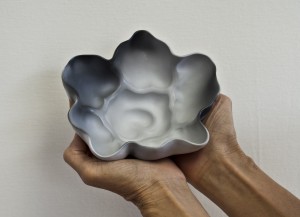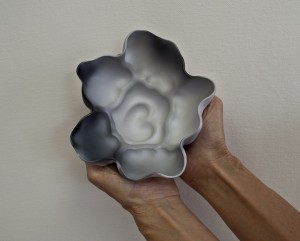Borrowed Plumes: “Pit Fired Pottery” Verses “Pit Finished Ceramics”
There is a very clear and fundamental distinction between “pit fired pottery” and “pit finished Ceramics”. This distinction has not been clearly made by Dawn Whitehand in her new book Pit Firing Ceramics: Modern Methods, Ancient Traditions. (Schiffer Publishing, 2013) Once a piece of raw clay has been bisque fired, in the controlled environment of a modern kiln, it can no longer be considered pit fired. It is no longer clay; it already is pottery and is now, by definition, being “pit finished”. This so called “pit firing” process has been reduced to a decorative surface technique. Americanized raku, saggar fired and pit finished ceramics all have this bisque fired element in common. Certainly, it is just as legitimate a firing technique as Americanized raku or saggar firing but it is not pit firing. The willingness to surrender to and participate fully with the transformative power of the savage element of fire is basic to the pit firing process.
Case in point: we refer to many forms of pottery as being hand made, but we make clear distinctions between; hand built, wheel thrown, thrown and altered, slab constructed, coil built and the pinch pot. This clarity is informative and educational and serves potters, buyers and the uninformed public alike. To claim that pottery that has been fired in the controlled environment of a modern kiln is pit fired is misleading (and a disservice to everyone involved.) There is an inherent disregard in this type of nonspacific misuse of terms for traditional pit firing potters, past and present, who fire without the insurance policy of a modern kiln. This willingness to risk weeks or months of work for the integrity of the process must be honored. As potters we need to be honest and clear about what we are doing and participate in this educational process. When we see pottery being described as “pit fired” we need to ask the potter, “Was this pottery pit fired or pit finished?” If the answer seems unclear or lacking in transparency, we need to ask again, “Was this pottery bisque fired in a kiln before being refired in a pit?” There is no shame in pit finished ceramics unless its flight is dependent upon the borrowed plumes of truly pit fired pottery.
Savage: having a wild untamed nature, not domesticated, ferocious, fierce.
This Noble Thing
We run the risk of losing something here.
Something Noble.
Something Powerful.
A human being behaving like a god.
Interacting intimately with the Fire.
And the Earth.
Without the safety net of technology to break their fall.
The humblest lowliest kind of god.
One that bows down to the Earth and asks permission.
And weeps and wails.
At the horrible possibility of being denied.
That approaches the fire in humility.
Willing to be burnt for Beauty and Truth.
God help us.
If in our haste.
We lose.
This.
Noble.
Thing.
Winds of Change
Is it really worth the risk?
To sacrifice, yet another slice of our humanities?
To betray,
the original indigenous spirit that dwells within us all?
But we really admire the ones, who live upon this earth,
listening,
and conversating with the spirit of the Land…
But cannot be bothered with the actual details of that conversation.
“But if the wind blows, the pots will break.”
Stop. And listen to that wind.
“But if the pots break, the students will cry.”
Stop. And listen to that wind.
Once,
along time ago,
I watched a hawk soaring far above my head.
And listened.
And He spoke, to me!
I was seen, by Him, as a relative.
And so He spoke.
“You have to really love the wind, if you want to learn to fly!”
The Hungry Wind
So you say the Wind might blow?
Perhaps, the hungry Wind is starving.
Starving to be fed,
fed, on our beauty.
And we refuse.
And the belly of the Wind is gnawing at itself.
And still we refuse.
To feed the spirit of the Wind, the Land, and the Sea.
And we ourselves are starving
and clawing for beauty
and meaning in our lives.
And still,
we send all our beauty to the bank.
And the spirit of the Wind, and the spirit of the Land, and the spirit of the Sea,
are starving.
We ourselves are well fed.
And yet we starve.
Because the spirit of the Wind, and Land, and Sea
cry out for our beauty.
And we send it
All
to the bank.


 RSS
RSS